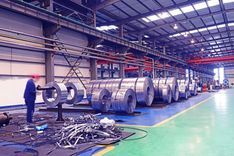Cold-rolled steel (CRS) is vital for precision industrial and machinery parts manufacturing due to its superior strength, dimensional accuracy, and high-quality surface finish. Industries such as automotive, aerospace, and medical equipment rely on CRS for components that require tight tolerances and exceptional durability.
According to the World Steel Association (2023), global demand for high-quality steel used in precision engineering has risen by 4.8% annually over the past decade. This increase is driven by advancements in automotive, aerospace, and industrial machinery sectors.
What makes cold-rolled steel different?
Cold-rolled steel is produced by further processing hot-rolled steel at room temperature through a series of rollers. This process refines its microstructure, increases tensile strength, and improves surface smoothness. The absence of high-temperature exposure ensures tight dimensional tolerances, absence of scale formation, thinner section size and a uniform finish, making CRS particularly useful for high-precision applications.
Key advantages of CRS in precision manufacturing
1. Superior dimensional accuracy
One of the greatest advantages of CRS is its ability to maintain tight tolerances. Manufacturers require materials that meet exact specifications without additional reworking. According to a report by Grand View Research (2023), over 65% of manufacturers in the aerospace and medical equipment industries prefer cold-rolled steel due to its minimal dimensional variation.
2. Higher strength and durability
Cold rolling increases the yield and tensile strength of steel by strain hardening mechanism, making it ideal for parts that require high load-bearing capacity. Data from the American Iron and Steel Institute (AISI, 2022) shows that CRS exhibits a 20-30% increase in tensile strength compared to its hot-rolled counterpart, making it suitable for critical industrial machinery components.
3. Improved surface finish
CRS is free from scale and oxidation, resulting in a smooth and polished surface. This is particularly beneficial for industries that require post-production treatments such as electroplating or painting. According to the European Steel Association (EUROFER, 2023), nearly 80% of CRS used in high-end manufacturing undergoes additional finishing processes, further enhancing its corrosion resistance and aesthetic appeal.
4. Greater formability and workability
Cold-rolled steel's consistent composition allows for better machinability, bending, and shaping without compromising its structural integrity. This makes it an excellent choice for fabricators producing intricate machinery parts, precision gears, and electronic enclosures.




 +91 7208055523
+91 7208055523
 Help & support
Help & support
